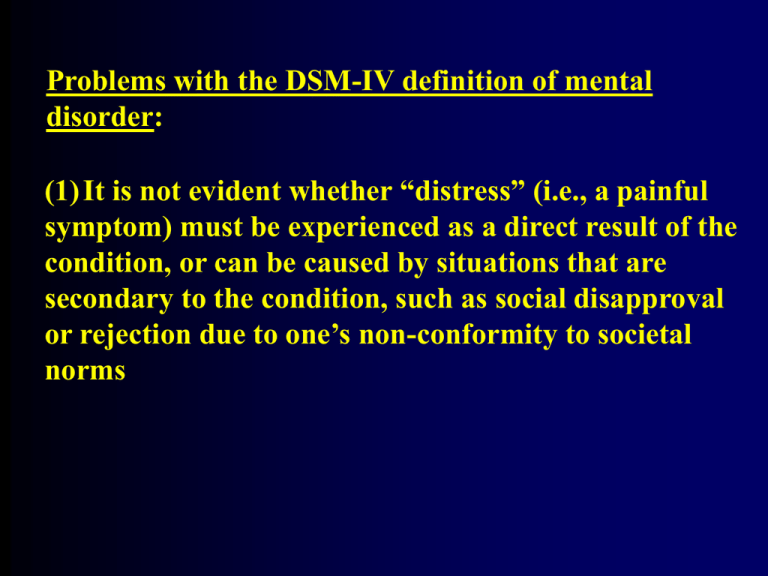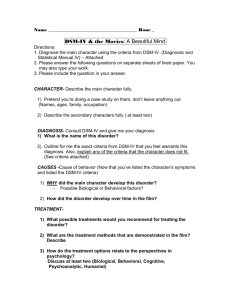Problems with the DSM-IV definition of mental disorder:
advertisement

Problems with the DSM-IV definition of mental disorder: (1) It is not evident whether “distress” (i.e., a painful symptom) must be experienced as a direct result of the condition, or can be caused by situations that are secondary to the condition, such as social disapproval or rejection due to one’s non-conformity to societal norms - the mere association of a particular behaviour with distress should not be sufficient to diagnose that behaviour a mental disorder - distress might be associated indirectly with a particular behaviour simply in response to having one’s desired manner of behaving thwarted (2) There are no object guidelines for assessing the presence of “clinically significant” distress. -As noted in the DSM-IV, such an assessment represents an “inherently difficult clinical judgment,” and “reliance on information from family members and other third parties (in addition to the individual) …is often necessary.” - A clarity with regards to the issue of what counts as “clinically significant distress” leaves interpretation open to the bias of the particular clinician involved - This is particularly important because there is sometimes a lack attention paid to self-reports of distress, and instead, diagnosis is primarily based on third party (i.e., family, friends, colleagues) reports - Third parties might report the “patient” is experiencing clinically significant distress, when in reality no such distress exists and, rather, it is those third party individuals that are distressed by the patient’s behaviour (3) It is unclear against what standard “disability” (i.e, impairment in one or more important areas of functioning) should assessed - In the absence of such guidelines, interpreting “disability” becomes a subjective judgment (4) It is unclear what counts as “an important loss of freedom” - once again this opens up interpretation to the particular biases of the clinician involved (5) Behaviours that might be considered “mental disorders” in Western culture, would simply be perceived expectable or culturally sanctioned response to a particular event - Ritualized fellatio of men by boys in Sambian culture (New Guinea) (6) The interpretation of “dysfunction” is open to interpretation given that no definition is provided in the DSM-IV - Some clinicians have argued that “dysfunction” refers to the “failure of some mechanism in a person to perform a natural function for which the mechanism was designed by natural selection.” - This notion of dysfunction is flawed - Just because some genetically-based trait was designed (i.e., produced by natural selection) for a particular function (i.e., an adaptive response to some environmental problem) does not mean that it cannot be co-opted in the present to serve some potentially adaptive function (or neutral role) that it was not specifically designed by natural selection to perform - Our mouths evolved to masticate food, but past selection for this adaptive function did not prohibit the masticatory structure from being co-opted for other adaptive functions like language production or neutral roles such as oral sex -A lack of some linear relationship between an “internal mechanism” and “past design” cannot be taken as evidence that the mechanism is dysfunctional (7) The DSM-IV provides no definition of what counts as “deviant behaviour” The Penguin Dictionary of Psychology definition: “Generally, any pattern of behavior that is markedly different from the accepted standards within a society. The connotation is always that moral or ethical issues are involved and, in use, the term is typically qualified to note the specific form, such as sexual deviance.” - This raises the possibility that some of the conditions described in the DSM-IV are deviant (i.e., morally and ethically questionable by certain segments of society), but they are not representative of a “disorder”



